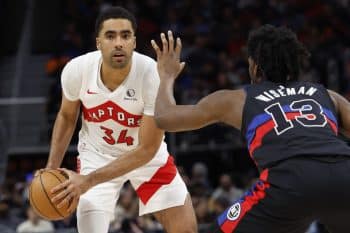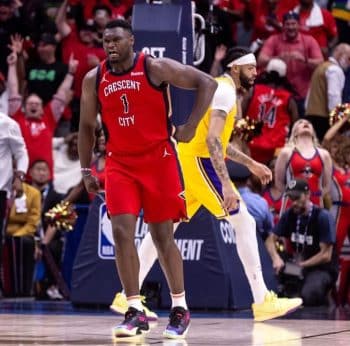NBA
NBA AM: How to Measure Individual Defense

Decoding offensive performance on the individual level has always been exponentially easier than doing so on the defensive end of the court. There are just so many more available benchmarks for offense such as points, assists, shooting percentages and numerous other extremely simple ways of quantifying a player’s value on the floor. Even just using our eyes, it’s typically far easier to watch an offensive play and immediately determine who did a good thing or a bad thing than it is to make the same assessment on the other end.
Accurate judgements of defenders on an individual basis are still possible, but they require a bit more legwork and, more importantly, an understanding of just how complex NBA defense can be. Assigning praise and blame can be such an indirect and imprecise process on this end of the floor, where all five guys have to work together and a damning mistake can happen far away from the ball. But it’s better to try than not, right? Let’s take a look at a few of the best available ways to track defensive value and performance.
The Basics:
The very lowest hanging fruit in these conversations comes in the form of the only two box score figures that are directly obtained while playing defense: steals and blocks. There’s certainly some broad, raw value to these numbers, and the league leaders will often feature some of the game’s better defenders.
With that said, their true uses are very limited; they capture just one small piece of what makes a good defender, and it’s very easy for players to excel at one or both of these particular skills despite sub-par play in many other vital areas. For example, a guy who gambles too often and jumps passing lanes all game long will rack up gaudy steal numbers, but is hurting his team in the long run due to all the possessions when he misses and ends up out of position.
Defensive rebounding is separated from the overall conversation by some, but certainly ties in and has some predictive value for defenders. Players who are best at keeping the opponent from rebounding their own misses (and therefore gaining extra chances to score) will naturally have value to a team’s defense, even if it’s indirect in many eyes.
Plus-Minus Metrics:
We discussed various plus-minus measures a couple months back, and they have some merit as indicators of an individual’s gross impact on his team on both ends of the floor. A specific variation’s effectiveness can vary wildly based on the inputs it uses and what it attempts to track. Stats like Defensive Win Shares are considered virtually useless among real statisticians; at the other end of the spectrum, Defensive Real Plus-Minus figures are, while far from perfect, a reasonably solid proxy for the value a given player adds or subtracts while on the floor. Even Real Plus-Minus and similar metrics should absolutely never be used as end-all rankings though, especially defensively. At best, they’re solid proxies with plenty of noise.
Another related variation of plus-minus figures are simple on/off court numbers, tracked in detail on NBA.com. These are what they sound like: A straightforward way to view a team’s performance with a given player on or off the floor. The league’s site allows for numerous areas of observation, from simple point differentials to detailed scoring, rebounding, passing and opponent data while a particular individual plays or sits. One of the simplest and most useful is points per-100-possessions. The Golden State Warriors, for instance, allow 95.3 points per-100-possessions while Draymond Green is on the floor (an excellent figure), but yield a yucky 108.4 when he hits the bench.
All these variations have necessary context involved, just like virtually everything in this piece. On/off figures are often incredibly noisy, unable to account for simple considerations like teammate and opponent lineup configurations. Sample sizes can be a hindrance with some players. RPM and other more detailed metrics do a decent job of controlling for some of these factors, but even the most detailed of them remains imprecise for concretely rating players on more than a broad scale.
Player Tracking:
Various player tracking systems have grown in popularity and availability in recent years, and represent the most advanced format available for measuring defensive performance. They’re the most detailed numbers out there and examine granular elements of the game in ways broader metrics simply can’t.
Tracking from Synergy Sports makes the list, though the defensive sections of their publicly available data on NBA.com are honestly pretty limited and should be taken with a hefty grain of salt in many areas. Synergy breaks the game down into play types – pick-and-roll, post up, transition, isolation, etc. Players and teams are tracked for various statistics within these play types, on both ends of the floor.
This service can be enormously valuable in many areas, but the vast majority of these are on the offensive side of the ball. The same issues as always with tracking defense arise even for such detailed services: How do you assign “responsibility” on a play where several defenders were involved and may have had some level of fault simultaneously? If a guard blows by his man on the perimeter and beats a slow help man to the rim for a dunk, which defender takes the blame? A perfect world gives some to both, but even the most advanced publicly available services don’t operate this way.
Synergy’s proprietary client (used by nearly every team in the league) offers both accompanying video and further levels of detail to all their figures, but the public stuff is limited. A keen eye to which areas are more robust is helpful – defensive figures in the post or on isolation are typically pretty clean and worth gleaning real insight from, where areas like pick-and-roll coverage or “defense” on spot-up shooters are so noisy that they should virtually be ignored altogether. Frankly, this page on NBA.com should come with a “Use With Caution” disclaimer.
A distant cousin to Synergy data is that of Vantage Sports, a site that utilizes similar tracking through a very different eventual lens. Vantage tracks even more granular data – things like screen navigation success rate and detailed levels of shot contests, minutiae that often more directly impacts the scoreboard. Vantage runs into some of the same tracking issues as Synergy, though, and in fact likely has far more trouble with accuracy within their metrics. Combine this with the fact that it’s a proprietary, non-public service, and it’s not worthy of much consideration for anyone but hardcore basketball junkies.
And finally, of course, there’s SportVU player tracking based on camera-recorded data tracked multiple times per second in every arena in the league. For one with an unlimited budget and access to proprietary data, this is far and away the most comprehensive way to determine defensive value on an individual and team basis. The full SportVU tracking database contains the maximum number of data points available to the game of basketball given modern technology.
Here’s the problem: No one in the public sphere has an unlimited budget or access to proprietary team data (more than an occasional sneak peak, at least). That’s not to say the bits we’re privy to are useless, or anywhere close. Publicly available SportVU data has increased in quantity on NBA.com each of the past three seasons including this one, and can be enormously valuable. It was recently announced that more media outlets will be given access to SportVU data in the near future, which means more data should trickle down to the public as well.
The most useful within the defensive sphere is SportVU rim protection data, which tracks how efficiently opponents score within five feet of the basket while a given player is defending it. The raw percentages allowed are informative enough, but the folks over at Nylon Calculus have taken it even further and currently house a list of the league’s best rim protectors based on “value saved” at the rim compared with league average.
There are other useful defensive elements within public SportVU data, but one needs a careful eye for them. SportVU has detailed rebounding figures that go a long way toward separating the “best” guys on the glass from the lucky ones, data that once again is housed in an even more informative manner on Nylon Calculus. NBA.com also now lists opposing field goal percentages allowed from every area of the floor, not just at the rim. Frankly, this data is pretty unreliable and should largely be avoided unless it’s complementary evidence that supports several other more robust metrics. There’s just way too much noise involved in determining whether the player physically closest to a shooter is always “responsible” for the result of his shot, and these figures alone are an easy way to incorrectly characterize a defender.
All of the above are useful and pragmatic ways to try and untangle the web of understanding NBA defense, but one disclaimer for finality’s sake: None of the publicly available data currently out there can give us 100 percent of the picture. Not even close. There’s simply too much going on to parse it all with concrete results – too many variables at play, too many pieces on the chessboard. Shoot, even the NBA GMs with access to the full SportVU data set – and therefore literally every single movement of every player at every moment on the court – would say that while it’s leaps and bounds better than anything that’s previously been available, it still has its flaws.
But isn’t that part of what keeps basketball so fun? The fact that we can’t know everything about a particular part of the game is what makes debates about it so entertaining. Would we even want a metric that solved NBA defense? No. We’ll always chase a higher level of understanding, and the metrics in this piece are a guide, but the magic of the game is the stuff we’ll never figure out.
*****
Listen to the latest episode of the Basketball Insiders podcast, in which Moke Hamilton and Ben Dowsett discuss their All-Star selections, the race for the eighth seed in each conference and the 12-man Olympic roster.











